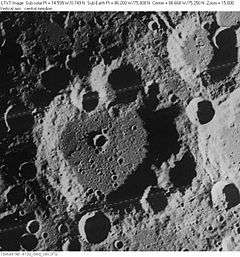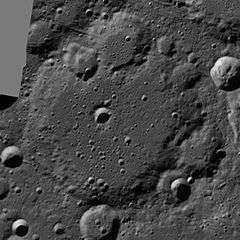Brianchon (crater)
|
LRO mosaic | |
| Coordinates | 74°48′N 86°30′W / 74.8°N 86.5°WCoordinates: 74°48′N 86°30′W / 74.8°N 86.5°W |
|---|---|
| Diameter | 145 km |
| Depth | Unknown |
| Colongitude | 95° at sunrise |
| Eponym | Charles J. Brianchon |

Brianchon is a lunar crater that is located along the northwestern limb of the Moon. Due to its location, from the Earth the crater is seen from the edge and its visibility is somewhat affected by libration. Thus for a more detailed view, the crater must be viewed from orbit.
This crater lies just to the west of the crater Pascal, and Desargues is to the southeast. To the south of Brianchon along the limb is the crater Cremona, while Lindblad lies to the southwest just on the far side of the Moon.
Brianchon has been worn and eroded by a history of impacts that followed its creation. The most prominent of these are a pair of craters that lie across the northern rim, and Brianchon B which intrudes slightly into the southern rim. Brianchon A forms an outward bulge in the rim to the northwest, but otherwise merges seamlessly into the crater formation. There is also a concentric crater formation intruding into the exterion of the southeastern rim. The remainder of the outer wall has been rounded, and is covered in a number of tiny craterlets.
The floor of the crater is relatively level, and is marked by a multitude of tiny craterlets. The most prominent of these is a small, bowl-shaped crater just to the northwest of the midpoint. The southern portion of the crater floor in particular contains a grouping of several tiny craterlets.
Satellite craters
By convention these features are identified on lunar maps by placing the letter on the side of the crater midpoint that is closest to Brianchon.
| Brianchon | Latitude | Longitude | Diameter |
|---|---|---|---|
| A | 76.7° N | 86.3° W | 50 km |
| B | 72.2° N | 89.1° W | 31 km |
| T | 75.8° N | 99.8° W | 30 km |
References
- Andersson, L. E.; Whitaker, E. A. (1982). NASA Catalogue of Lunar Nomenclature. NASA RP-1097.
- Blue, Jennifer (July 25, 2007). "Gazetteer of Planetary Nomenclature". USGS. Retrieved 2007-08-05.
- Bussey, B.; Spudis, P. (2004). The Clementine Atlas of the Moon. New York: Cambridge University Press. ISBN 978-0-521-81528-4.
- Cocks, Elijah E.; Cocks, Josiah C. (1995). Who's Who on the Moon: A Biographical Dictionary of Lunar Nomenclature. Tudor Publishers. ISBN 978-0-936389-27-1.
- McDowell, Jonathan (July 15, 2007). "Lunar Nomenclature". Jonathan's Space Report. Retrieved 2007-10-24.
- Menzel, D. H.; Minnaert, M.; Levin, B.; Dollfus, A.; Bell, B. (1971). "Report on Lunar Nomenclature by the Working Group of Commission 17 of the IAU". Space Science Reviews. 12 (2): 136–186. Bibcode:1971SSRv...12..136M. doi:10.1007/BF00171763.
- Moore, Patrick (2001). On the Moon. Sterling Publishing Co. ISBN 978-0-304-35469-6.
- Price, Fred W. (1988). The Moon Observer's Handbook. Cambridge University Press. ISBN 978-0-521-33500-3.
- Rükl, Antonín (1990). Atlas of the Moon. Kalmbach Books. ISBN 978-0-913135-17-4.
- Webb, Rev. T. W. (1962). Celestial Objects for Common Telescopes (6th revised ed.). Dover. ISBN 978-0-486-20917-3.
- Whitaker, Ewen A. (1999). Mapping and Naming the Moon. Cambridge University Press. ISBN 978-0-521-62248-6.
- Wlasuk, Peter T. (2000). Observing the Moon. Springer. ISBN 978-1-85233-193-1.
